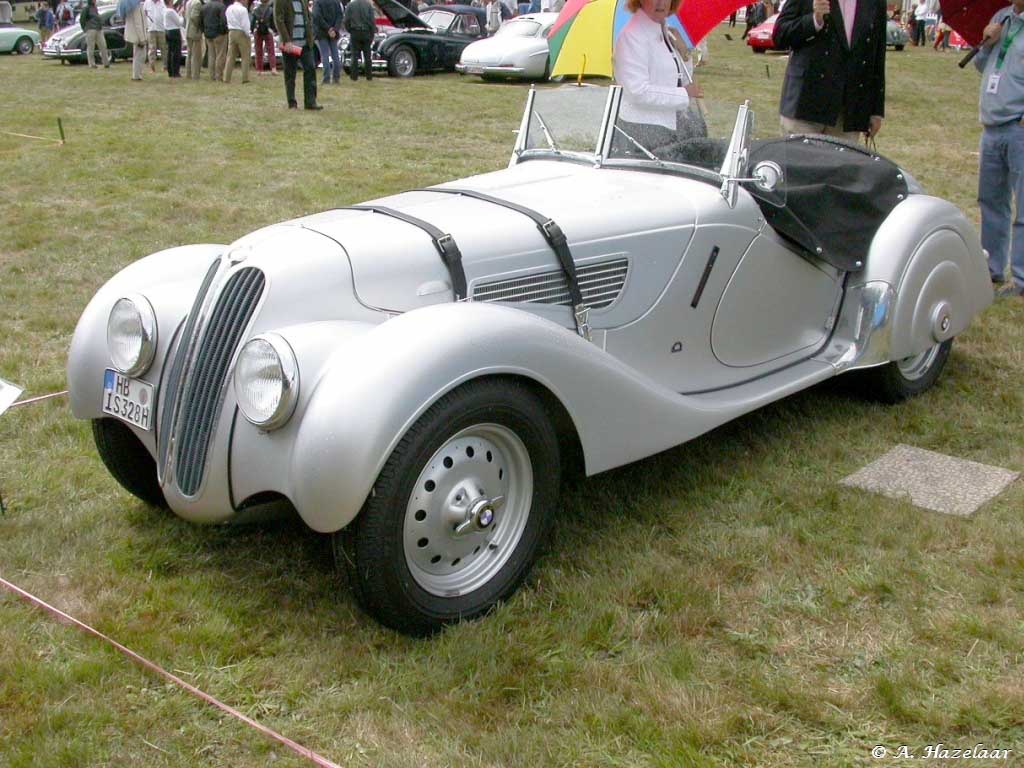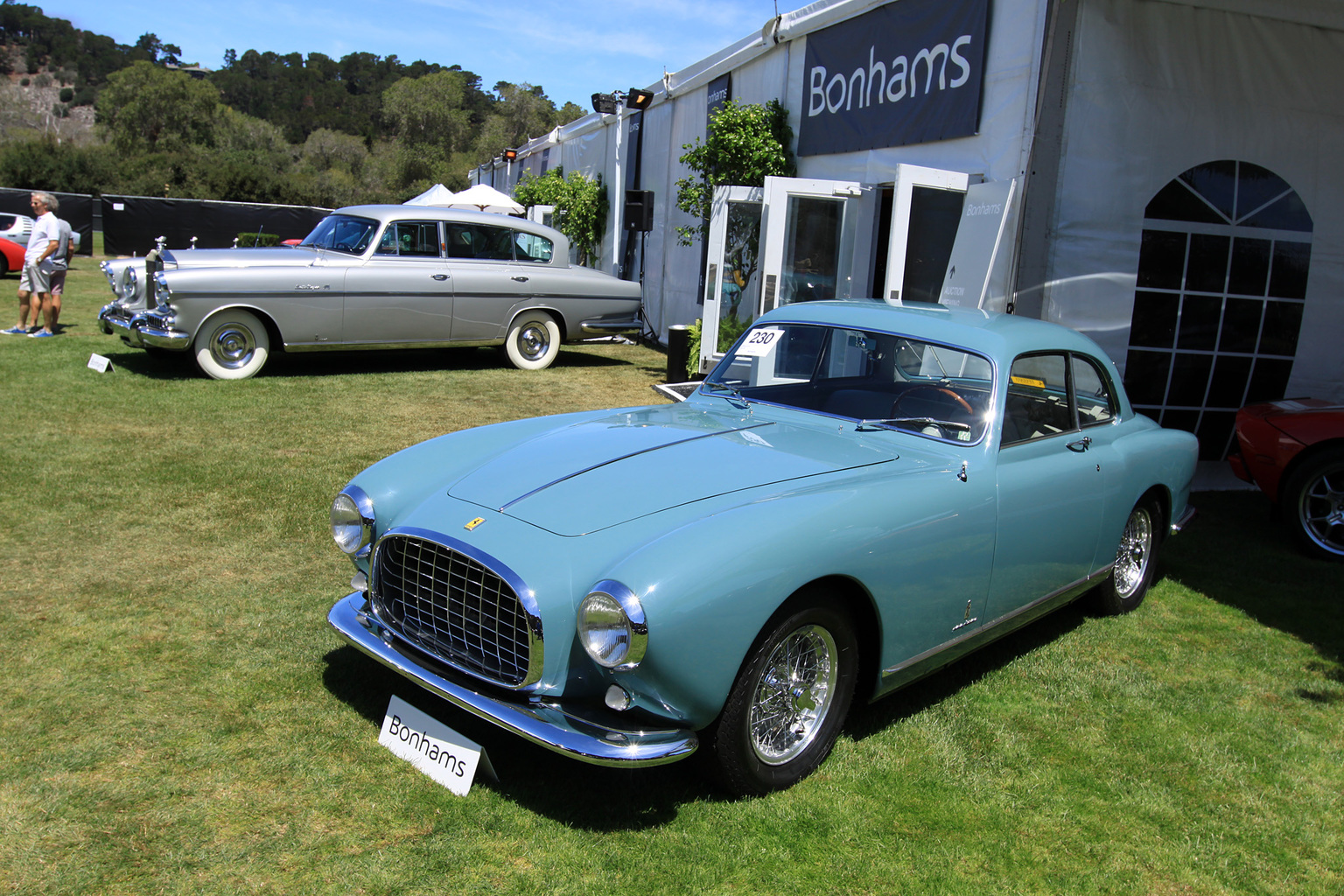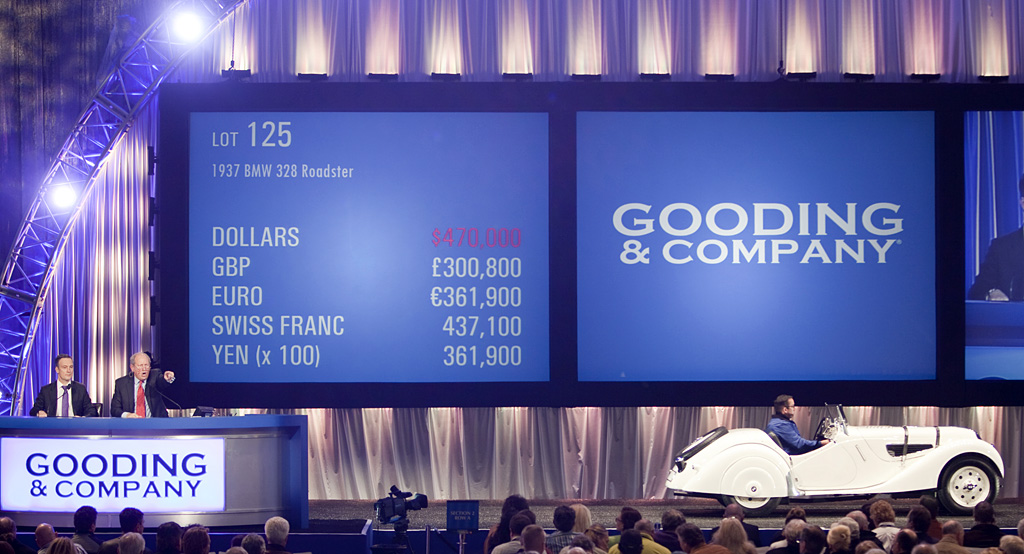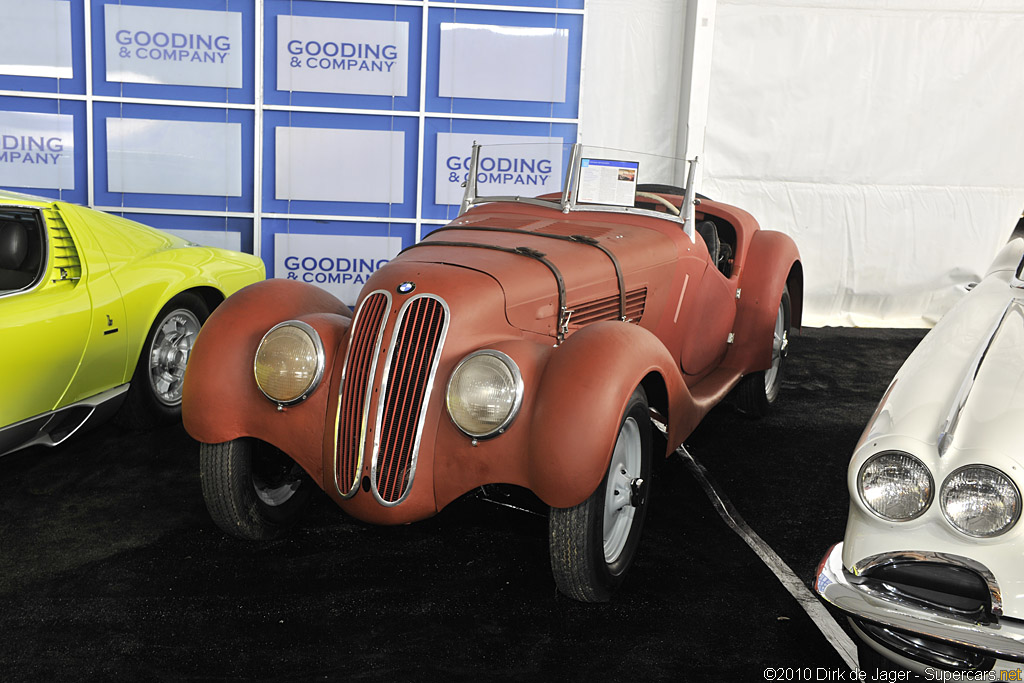1936 BMW 328 Roadster
A small brochure circulated among a select group of people in late 1935 revealed the existence of a new 2-litre sports car to be known as the “Typ 328”. The description of the car was deliberately low-key and avoided giving any performance or speed figures. The brochure was intended purely as an appetiser for “friends of the company”; there was no announcement in the press.
Journalists were left open-mouthed when they set eyes on the car for the first time in the Nürburgring paddock on 13 June 1936. There, Ernst Henne was preparing to race the 328 in the International Eifel Race the following day. The motorcycle world record holder roared away from his rivals off the start line and soon left the rest of the field trailing in his wake with a phenomenal average speed of 101.5 km/h. This show of strength from the 328 had commentators purring about the future of the German sports car. However, few could have guessed that they were witnessing the dawn of a new era.
Few observers are likely to have fully grasped what was unfolding in front of them that day. In an earlier press release BMW had itself downplayed the new model as a “2-litre sports car with a slightly more streamlined body”, lulling some journalists – who referred only to its “2-litre V engine with twin camshafts” – into a misplaced sense of the ordinary. The understated approach might well have been a tactic on BMW’s part to avoid raising hopes too high, too quickly; after all, by that point only three prototypes had been built.
”It’s amazing what Henne gets out of this new 2-litre engine. What superb acceleration! He shoots off down the long straight and into the turns and bends of the circuit… this sports car is faster than any other car with a super-charged engine! With a clear lead Henne reaches the finishing line…’
What the Motorwelt described so enthusiastically was the result of a rapid development. The engineers, mechanics and designers of the BMW development department in Munich had little time and money to create this sports car. They had to focus on the essential, and perhaps this is precisely what made this car so successful. Within a short while the BMW 328 acquired a dominating position in its class, often even outperforming competitors with significantly more power. A maximum output of 80 bhp at a weight of only 830 kg helped the elegant series-production version of the roadster to develop impressive power.
The wins keep coming
The second victory for the 328 arrived in August, with British BMW importer H.J. Aldington sweeping all before him in the Schleißheimer Dreiecksrennen race. Aldington then persuaded the powers-that-be at BMW to give the car another run outside Germany. The three prototypes duly made their way to Ireland for the Tourist Trophy sporting green Frazer-Nash-BMW livery – and cantered to a 1-2-3. The 328 had got the ball rolling and several more victories followed over the ensuing months. However, it was still the three pre-production cars taking it in turns to rack up the wins, with various drivers at the wheel.
Private customers were forced to play the waiting game, as production was slow to get off the ground; the first cars were not delivered to customers until late April 1937. And so it was exactly a year since Henne’s debut outing before the first private owner of a BMW 328 had the chance to test his new purchase in race action.
At the 1937 Eifel Race it was left to the nine BMW 328 racers on the grid to fight it out for victory. Over the years that followed only a handful of cowed attempts were made by other cars to take on the hot-heeled BMWs. These intrepid lone rangers were doomed to failure as the BMW 328 quickly took Germany’s race tracks by storm.
Reports of victories continued to rain into Munich from every corner of Europe. And it wasn’t only class wins that the car was amassing so effortlessly, as much more powerfully-engined cars also succumbed to its irresistible will. The small 2-litre sports car was building a handsome collection of overall victories over once superior rivals.
Between April 1936 and September 1939, 464 units of the BMW 328 were produced. By 1940 this sports car had participated in 172 national and international races, achieving 141 victories in the process, many of which were legendary such as the overall victory and the team victory in the 1940 Mille Miglia race. Featuring the special roadster and coupé body by Carrozzeria Touring of Milan, the 328 did the 1,000 miles at an average speed of 166.7 kilometres per hour (104 mph). The thin aluminium skin of these Superleggera bodies is directly fixed to the delicate, load-bearing tubular space frame, giving the coupé a weight of only 780 kg and a top speed of 220 km/h (137 mph).
1938 Mille Miglia
1937 had been a hugely successful year for BMW and its new sports car. The BMW 328 had run out of rivals in the 2-litre class in Germany, and it had also put itself on the radar of sports car drivers in other countries with a string of successes abroad, mostly with Ernst Henne at the wheel. Now BMW needed the big international breakthrough, a triumph on foreign soil that would make headlines far and wide.
While central Europe remained firmly in winter’s grip, south of the Alps the motor sports community was priming itself for a race which had, over many years, become one of the most famous on the calendar: the Mille Miglia. On 3 April 1938 this legendary road race, starting for the 12th time from Brescia and leading through half of Italy, would send a whole nation into an unimaginable frenzy of enthusiasm. Preparations had been under way for months already, garages humming to the sound of racing cars flexing their muscles. At the Munich racing department, too, the engineers were hard at work, readying a brace of works cars for action.
The race organisers had revised the class boundaries for the 1938 event. The national sports car class was joined by categories for international sports cars with and without a supercharger. Of the 155 drivers entered for the race, 119 lined up in the national class, highlighting the Mille Miglia’s status as first and foremost an Italian national event. The smallest class in which international drivers could compete was therefore the 2-litre sports car class.
In 1938 the organisers set out to encourage more foreign, i.e. German, drivers to take part. However, only four drivers responded to the appeal, all entering BMW 328 racers. The NSKK (National Socialist Motoring Corps) registered Prince Max zu Schaumburg-Lippe as its driver and – as a manifestation of the German-Italian friendship – the experienced Mille Miglia campaigner Count Giovanni Lurani as co-driver. BMW sent two works cars to the race, one manned by privateer drivers Uli Richter and Dr Fritz Werneck, the other piloted by Britain’s A.F.P. Fane with William James alongside as his mechanic and navigator.
These three cars made up a team managed by Ernst Loof, head of the BMW racing department, and they were joined by the privately-entered driver/mechanic pairing of Heinrich Graf von der Mühle-Eckart and Theodor Holzschuh, an employee at the BMW sports car repairs department. Also on the start list were a Fiat, a Riley and an Aston Martin.
The weather for the race could hardly have been more perfect. Brescia had been basking in spring warmth for several days already, and only at the start of the race was there a slight chill in the air.
The centre of Brescia was alive with anticipation over the night from 2–3 April. Thousands of excited onlookers had gathered at the start and lined the roads leading into the city to witness the unfolding of this extraordinary event. At 2.00 a.m. the first cars in the smallest-capacity section of the national class were waved on their way. The cars started at 30-second or one-minute intervals, according to the class. The long list of entrants meant that the first test for the drivers of the larger cars was one of patience. At least they could relax in the knowledge that they would be driving in daylight, although that also meant they would have a lot of overtaking to do.
By contrast, darkness had yet to yield when the cars in the 2-litre class were called to the starting line. Prince Schaumburg was the first to set off into the Italian night, on the stroke of 4.30 a.m., followed by Uli Richter, the three non-BMW cars, Fane and von der Mühle-Eckart. The BMW racers wasted no time in setting a withering pace, showing enviable confidence in the durability of their beautifully prepared race engines. By the time they reached Rome they had already seen off the challenge of two of the other manufacturers in their category, and the third was forced to retire shortly afterwards. But the BMWs were not about to slow down to celebrate. Quite the opposite, in fact. With their class rivals out of the picture, they were free to launch an attack on the more powerful cars. The Germans were driving with clockwork precision, and only a few minutes separated them at any one time.
The fastest drivers arrived back in Brescia in the late afternoon. Less than 12 hours after crossing the start line, the powerful supercharged Alfa Romeos, the Delahayes and the Talbots were back at base, as expected. The big surprise, though, was still to come; Fane steered his BMW 328 to eighth place in the overall classification, winning the 2-litre class and leaving a considerable number of supercharged cars in his wake in the process. Fane’s fellow-BMW 328s followed him home in 10th, 11th and 12th overall, securing 2nd, 3rd and 4th places in their class and rounding off a spectacular race for BMW. Added to which, they also won the team prize for consistency and the award for the best foreign entrant.
BMW’s pride in claiming the biggest win in the company’s history was obvious. The 328 had proved that it was capable of sustaining incredibly high speeds over long distances without complaint. The car’s combination of impressive output and flawless roadholding had shown that it was possible to defeat the challenge of far more powerful rivals. For BMW this success represented the international breakthrough in European motor sport.
1936 BMW 328 Roadster Gallery
See full 1936 BMW 328 Roadster Gallery here
In Detail
| built at | Munich, Germany |
| engine | Inline-6 |
| valvetrain | OHV 2 Valves / Cyl |
| displacement | 1971 cc / 120.3 in³ |
| bore | 66 mm / 2.6 in |
| stroke | 96 mm / 3.78 in |
| compression | 7.5:1 |
| power | 59.7 kw / 80.1 bhp @ 5000 rpm |
| specific output | 40.64 bhp per litre |
| bhp/weight | 96.51 bhp per tonne |
| torque | 126.09 nm / 93.0 ft lbs @ 4000 rpm |
| curb weight | 830 kg / 1830 lbs |
| wheelbase | 2400 mm / 94.5 in |
| front track | 1150 mm / 45.3 in |
| rear track | 1220 mm / 48.0 in |
| length | 3900 mm / 153.5 in |
| width | 1550 mm / 61.0 in |
| height | 1400 mm / 55.1 in |
| transmission | 4-Speed Manual |
| final drive | 3.88:1 |
Auction Sales History
1937 BMW 328 Roadster 85095 – sold for $990,000 Formerly part of the Dr. Frederick A. Simeone Collection. Ground up restoration by Blackhorse Garage. Complete engine rebuild by Stanton Engineering. One of only 463 built. Mille Miglia eligible.
Auction Source: 2014 Quail Lodge Auction by Bonhams
1937 BMW 328 Roadster 85135 – sold for $517,000 A Connoisseur’s Vintage Sports Car. One of Only 463 Built. Desirable Early Production Example. Equipped with OZ 80 Cylinder Head. Classic German Motor Sport Livery. Eligible for the Finest Vintage Races, Rallies and Concours.
Auction Source: 2012 Scottsdale Auction by Gooding & Company
1939 BMW 328 Roadster 85406 – sold for $539,000 Formerly part of the Simeone Foundation Museum collection in Philadelphia. Over the course of its life, the car has been refinished in white and the upholstery was redone, but otherwise the car is extremely original down to the chassis. Mr. Simeone reports, however, that the engine is not original to the car and comes from a BMW 326 (year 1937) that was mated to a 328 cylinder head but retains the original Solex IF30 carburetors.
Auction Source: RM Auctions’ 2010 Sports & Classics of Monterey
1938 BMW 328 Roadster 85144 – did not sell for $320,000 Of the original 463 examples produced, only an estimated 180 genuine examples survive to this day. To find an original 328 Roadster in this state has become exceedingly rare and this car represents a unique opportunity to acquire, finish and enjoy an important car whose brilliance is unquestioned. Gooding & Company is proud to present an example of this rare breed, and we encourage close inspection and consideration of this outstanding pre-war sports car.
Auction Source: 2010 Gooding & Company Pebble Beach Auction









